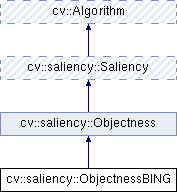Objectness algorithms based on [3] [3] Cheng, Ming-Ming, et al. "BING: Binarized normed gradients for objectness estimation at 300fps." IEEE CVPR. 2014.
More...
#include "saliencySpecializedClasses.hpp"
Objectness algorithms based on [3] [3] Cheng, Ming-Ming, et al. "BING: Binarized normed gradients for objectness estimation at 300fps." IEEE CVPR. 2014.
the Binarized normed gradients algorithm from [27]
| cv::saliency::ObjectnessBING::ObjectnessBING |
( |
| ) |
|
| virtual cv::saliency::ObjectnessBING::~ObjectnessBING |
( |
| ) |
|
|
virtual |
| bool cv::saliency::ObjectnessBING::computeSaliencyImpl |
( |
InputArray |
image, |
|
|
OutputArray |
objectnessBoundingBox |
|
) |
| |
|
protectedvirtual |
Performs all the operations and calls all internal functions necessary for the accomplishment of the Binarized normed gradients algorithm.
- Parameters
-
| image | input image. According to the needs of this specialized algorithm, the param image is a single Mat |
| objectnessBoundingBox | objectness Bounding Box vector. According to the result given by this specialized algorithm, the objectnessBoundingBox is a vector<Vec4i>. Each bounding box is represented by a Vec4i for (minX, minY, maxX, maxY). |
Implements cv::saliency::Objectness.
| double cv::saliency::ObjectnessBING::getBase |
( |
| ) |
const |
|
inline |
| int cv::saliency::ObjectnessBING::getNSS |
( |
| ) |
const |
|
inline |
| std::vector<float> cv::saliency::ObjectnessBING::getobjectnessValues |
( |
| ) |
|
Return the list of the rectangles' objectness value,.
in the same order as the vector<Vec4i> objectnessBoundingBox returned by the algorithm (in computeSaliencyImpl function). The bigger value these scores are, it is more likely to be an object window.
| int cv::saliency::ObjectnessBING::getW |
( |
| ) |
const |
|
inline |
| void cv::saliency::ObjectnessBING::read |
( |
| ) |
|
| void cv::saliency::ObjectnessBING::setBase |
( |
double |
val | ) |
|
|
inline |
| void cv::saliency::ObjectnessBING::setBBResDir |
( |
std::string |
resultsDir | ) |
|
This is a utility function that allows to set an arbitrary path in which the algorithm will save the optional results.
(ie writing on file the total number and the list of rectangles returned by objectess, one for each row).
- Parameters
-
| resultsDir | results' folder path |
| void cv::saliency::ObjectnessBING::setNSS |
( |
int |
val | ) |
|
|
inline |
| void cv::saliency::ObjectnessBING::setTrainingPath |
( |
std::string |
trainingPath | ) |
|
This is a utility function that allows to set the correct path from which the algorithm will load the trained model.
- Parameters
-
| trainingPath | trained model path |
| void cv::saliency::ObjectnessBING::setW |
( |
int |
val | ) |
|
|
inline |
| void cv::saliency::ObjectnessBING::write |
( |
| ) |
const |
The documentation for this class was generated from the following file:



 Public Member Functions inherited from cv::saliency::Saliency
Public Member Functions inherited from cv::saliency::Saliency Public Member Functions inherited from cv::Algorithm
Public Member Functions inherited from cv::Algorithm Static Public Member Functions inherited from cv::saliency::Saliency
Static Public Member Functions inherited from cv::saliency::Saliency Static Public Member Functions inherited from cv::Algorithm
Static Public Member Functions inherited from cv::Algorithm Protected Attributes inherited from cv::saliency::Saliency
Protected Attributes inherited from cv::saliency::Saliency 1.8.9.1
1.8.9.1